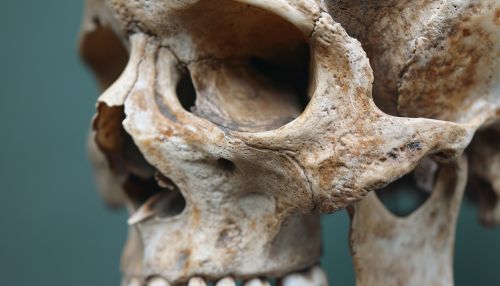Skull
Anatomy
The human skull is a complex structure composed of 22 bones that form the framework for the head and face. It protects the brain, supports the structures of the face, and provides a solid base for the attachment of muscles. The skull is divided into two main parts: the cranial bones which encase the brain, and the facial bones which form the upper and lower jaws, nose, orbits (eye sockets), and other facial structures.


Cranial Bones
The cranial bones are eight in number and form the protective cranial vault that houses the brain. The eight cranial bones are: the frontal, two parietal, two temporal, occipital, sphenoid, and ethmoid bones. These bones are connected by joints called sutures, which are immovable in adults.
Frontal Bone
The frontal bone forms the forehead and the roofs of the orbits. It also contains the frontal sinuses, which are air-filled cavities.
Parietal Bones
The two parietal bones form the sides and roof of the cranial vault. They meet at the top of the skull in a suture known as the sagittal suture.
Temporal Bones
The temporal bones are located on the sides of the skull, beneath the parietal bones. They house the structures of the inner and middle ear.
Occipital Bone
The occipital bone forms the back and base of the skull. It contains a large opening, the foramen magnum, through which the spinal cord passes.
Sphenoid Bone
The sphenoid bone is located at the base of the skull. It is shaped like a butterfly and has two wings that extend out to the sides.
Ethmoid Bone
The ethmoid bone is a small, delicate bone located in the midline of the skull, between the two orbits. It forms part of the nasal cavity and contains numerous air cells.
Facial Bones
The facial bones are 14 in number and provide the framework for the facial structures. They also form the upper and lower jaws, the nasal cavity, the orbits, and the palate. The facial bones are: two maxillae, two palatine bones, two zygomatic bones, two lacrimal bones, two nasal bones, two inferior nasal conchae, the vomer, and the mandible.
Maxillae
The maxillae are the largest facial bones. They form the upper jaw and the lower part of the orbits. Each maxilla contains a large air-filled cavity called the maxillary sinus.
Palatine Bones
The palatine bones form the back part of the roof of the mouth (hard palate) and the floor of the nasal cavity.
Zygomatic Bones
The zygomatic bones form the cheekbones and the lateral walls of the orbits.
Lacrimal Bones
The lacrimal bones are the smallest bones of the face. They are located in the medial walls of the orbits and contain the lacrimal sacs, which collect tears.
Nasal Bones
The nasal bones form the bridge of the nose.
Inferior Nasal Conchae
The inferior nasal conchae are curved bones that form part of the lateral walls of the nasal cavity.
Vomer
The vomer is a thin, flat bone that forms the lower part of the nasal septum.
Mandible
The mandible is the largest and strongest bone of the face. It forms the lower jaw and contains the lower teeth.
Development
The skull develops from a series of bony plates that gradually fuse together during childhood and adolescence. This process, known as ossification, begins in the womb and continues until the late teens or early twenties. The last bones to fuse are the sutures of the cranial vault, which close by the age of 25.
Pathology
Various diseases and conditions can affect the skull, including fractures, infections, tumors, and developmental disorders. Skull fractures are a common type of injury, often resulting from trauma to the head. Infections can lead to osteomyelitis, a serious condition that can cause bone damage. Tumors can arise from the bone itself or from the tissues within the skull, such as the brain or the sinuses. Developmental disorders, such as craniosynostosis, occur when the sutures of the skull fuse prematurely, leading to abnormal skull shape and potentially impairing brain development.
